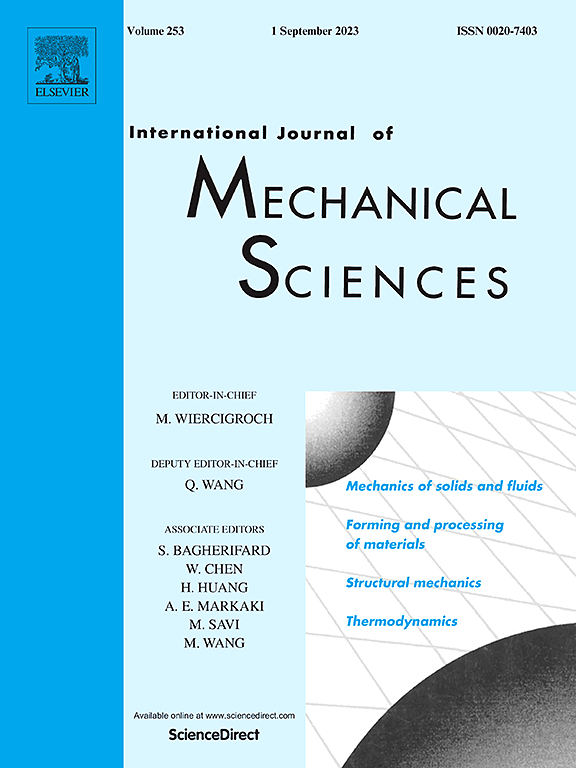支承松动故障下转子-支承-机匣系统的非线性动力学
IF 7.1
1区 工程技术
Q1 ENGINEERING, MECHANICAL
International Journal of Mechanical Sciences
Pub Date : 2025-06-20
DOI:10.1016/j.ijmecsci.2025.110482
引用次数: 0
摘要
本文提出了一种结合显式格式和隐式格式的时域数值方法,用于有效求解具有局部非线性的高维系统。应用该方法对存在支承松动故障的转子-支承-机匣系统的非线性动态特性进行了研究。建立了包含非线性轴承、挤压膜阻尼器(SFD)以及轴承与外壳之间的接触相互作用的多界面非线性支承的动力学模型。通过模态试验和振动响应实验对模型进行了验证。为了获得系统的振动响应,提出了一种混合数值积分方法,其核心是优化迭代求解过程。该方法对系统的线性部分和非线性部分进行分离,采用显式格式预测耦合节点响应,分别采用隐式数值方法和准牛顿迭代算法求解线性部分和非线性部分。与传统方法相比,该方法显著提高了计算效率。在此基础上,研究了转子转速、配合间隙和油膜间隙对支架松动故障下转子-支架-机匣系统动态响应的影响。结果表明,支架松动会改变系统的稳定性,导致周期、多周期和准周期响应。配合间隙和油膜间隙对系统的非线性行为有显著影响。在严重故障情况下,套管振动响应中出现分数阶转速谐波。所提出的建模方法和混合数值方法在航空发动机振动预测中具有很强的工程应用潜力。本文章由计算机程序翻译,如有差异,请以英文原文为准。

Nonlinear dynamics of rotor-support-casing system with support looseness fault
This paper proposes a time-domain numerical method combining explicit and implicit schemes for efficiently solving high-dimensional systems with localized nonlinearities. This method is applied to investigate the nonlinear dynamic characteristics of a rotor-support-casing system with support looseness fault. A dynamic model incorporating multi-interface nonlinear supports is developed, which includes nonlinear bearings, a squeeze film damper (SFD), and the contact interaction between the bearing and its housing. The model is validated through modal testing and vibration response experiments. To obtain the vibration response of the system, a hybrid numerical integration method is proposed, with its core focused on optimizing the iterative solution process. This method separates the linear and nonlinear parts of the system, predicts the coupling node response using an explicit scheme, and solves the linear and nonlinear parts using an implicit numerical method and a quasi-Newton iterative algorithm, respectively. Compared with conventional approaches, this method significantly improves computational efficiency. Subsequently, the effects of rotor speed, fit clearance, and oil film clearance in SFD on the dynamic response of the rotor-support-casing system under support looseness faults are investigated. The results show that support looseness alters system stability, leading to periodic, multi-periodic, and quasi-periodic responses. Both fit clearance and oil film clearance significantly influence the system’s nonlinear behavior. Under serious fault conditions, fractional-order rotational speed harmonics appear in the casing vibration response. The proposed modeling approach and hybrid numerical method demonstrate strong potential for engineering applications in aero-engine vibration prediction.
求助全文
通过发布文献求助,成功后即可免费获取论文全文。
去求助
来源期刊

International Journal of Mechanical Sciences
工程技术-工程:机械
CiteScore
12.80
自引率
17.80%
发文量
769
审稿时长
19 days
期刊介绍:
The International Journal of Mechanical Sciences (IJMS) serves as a global platform for the publication and dissemination of original research that contributes to a deeper scientific understanding of the fundamental disciplines within mechanical, civil, and material engineering.
The primary focus of IJMS is to showcase innovative and ground-breaking work that utilizes analytical and computational modeling techniques, such as Finite Element Method (FEM), Boundary Element Method (BEM), and mesh-free methods, among others. These modeling methods are applied to diverse fields including rigid-body mechanics (e.g., dynamics, vibration, stability), structural mechanics, metal forming, advanced materials (e.g., metals, composites, cellular, smart) behavior and applications, impact mechanics, strain localization, and other nonlinear effects (e.g., large deflections, plasticity, fracture).
Additionally, IJMS covers the realms of fluid mechanics (both external and internal flows), tribology, thermodynamics, and materials processing. These subjects collectively form the core of the journal's content.
In summary, IJMS provides a prestigious platform for researchers to present their original contributions, shedding light on analytical and computational modeling methods in various areas of mechanical engineering, as well as exploring the behavior and application of advanced materials, fluid mechanics, thermodynamics, and materials processing.
 求助内容:
求助内容: 应助结果提醒方式:
应助结果提醒方式:


